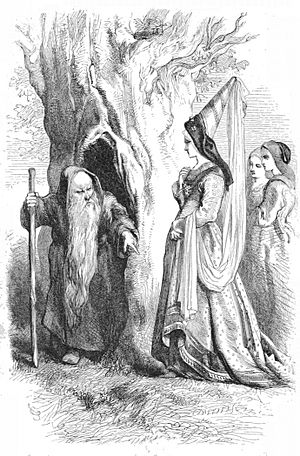Princess Rosette facts for kids
Princess Rosette is a classic fairy tale from France. It was written by Madame d'Aulnoy, a famous French author. This story was also included in The Red Fairy Book by Andrew Lang, which is a well-known collection of fairy tales.
The story of Princess Rosette has been retold in different ways. For example, Italo Calvino collected a similar tale called The King of the Peacocks for his book Italian Folktales. He noted that it was very much like Princess Rosette.
Contents
The Story of Princess Rosette
A Royal Prophecy
Once upon a time, a king and queen had two sons. Later, they were blessed with a daughter, whom they named Rosette. All the fairies were invited to her christening. The queen asked them to predict Rosette's future. The fairies gave a worrying prophecy: Rosette might cause great trouble for her brothers, possibly even leading to their deaths.
To protect their sons, the king and queen sought advice from a wise hermit. He told them to lock Rosette away in a tall tower. They followed his advice. However, one day, the king and queen passed away. Their sons, now grown, immediately freed their sister from the tower.
Princess Rosette was amazed by everything she saw outside. She was especially fascinated by a beautiful peacock. When she learned that people sometimes ate peacocks, she was shocked. She declared that she would only marry the King of the Peacocks. This way, she could protect all peacocks as her subjects.
The Search for the King of Peacocks
Rosette's brothers, one now the new king and the other a prince, decided to help her. They set out on a long journey to find the King of the Peacocks. After a long search, the King of the Mayflies finally directed them to his kingdom.
There, they met the King of the Peacocks. They showed him a portrait of Princess Rosette. The king said he would marry her if she was as beautiful as her picture. But he also warned them: if she was not, he would have both brothers killed.
A Tricky Nurse
When the news reached Princess Rosette, she began her journey to meet the King of the Peacocks. Her old nurse traveled with her. During the journey, the nurse secretly bribed the boatman. In the middle of the night, the boatman threw the princess, her bed, and her little dog into the sea. Luckily, the bed was made of special Phoenix feathers, so it floated.
The wicked nurse then put her own daughter in the princess's place. When they arrived, the King of the Peacocks was furious. He saw the nurse's daughter and thought she was Rosette. He believed the brothers had tricked him. He was about to execute them. However, the brothers managed to convince him to give them seven days to prove their innocence.
Rosette's Discovery

When Princess Rosette woke up, floating in the sea, she thought the king had decided not to marry her. She believed he had ordered her to be thrown into the water. An old man saw her on the shore and brought her to his humble home. He realized from her belongings that she was a very important lady. He felt bad that he could only offer her simple food.
The clever princess sent her little dog to the best kitchen in town. The dog managed to steal all the food being cooked for the King of the Peacocks! This happened for several days. Finally, the Prime Minister decided to spy on the kitchen. He saw the dog, followed it, and discovered Rosette.
He told the king, and they went to the hut to seize Rosette and the old man. The old man begged for mercy and explained everything that had happened. The king then realized that this beautiful girl was his true bride, Princess Rosette! He immediately freed her innocent brothers and married the real princess.
Legacy of the Tale
This fairy tale has been popular for a long time. In the late 18th century, a version of the story was translated and called The Princess Rosetta. Later, an illustrator named Katherine Pyle also published the story using the name Princess Rosetta.
The tale was also turned into a play. James Planché adapted many of Madame d'Aulnoy's stories for the stage. He used Princess Rosette as the basis for his play called The King of the Peacocks. The story was even translated into Norwegian as Prindsesse Rosette, et Fee-Eventyr.


